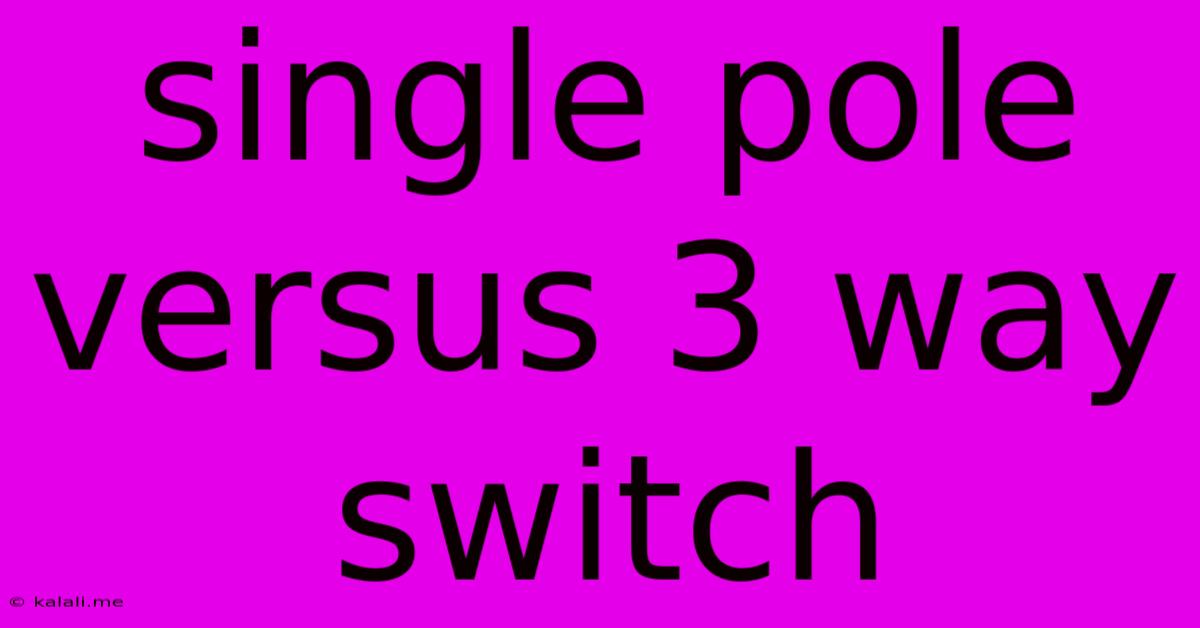Single Pole Versus 3 Way Switch
Kalali
Jun 07, 2025 · 3 min read

Table of Contents
Single Pole vs. 3-Way Switch: Illuminating the Differences
Choosing between a single pole switch and a 3-way switch can seem confusing, especially for DIY enthusiasts tackling home electrical projects. This article clarifies the key differences, helping you select the right switch for your lighting needs and ensuring a safe and functional electrical system. Understanding the distinctions will empower you to confidently manage your home's lighting setup, avoiding common pitfalls and maximizing your home's electrical efficiency.
What is a Single Pole Switch?
A single pole switch is the most common type of light switch found in homes. It controls a light fixture from a single location. Think of the typical setup in a bedroom or bathroom: you flip the switch on the wall, and the light either turns on or off. It's a simple, straightforward system ideal for controlling lights from one point. This is a fundamental component in basic home wiring and perfect for simple lighting control needs. Single-pole switches offer simplicity and ease of installation.
What is a 3-Way Switch?
A 3-way switch, on the other hand, allows you to control a light fixture from two different locations. This is incredibly convenient for hallways, stairwells, or rooms with entry points on opposite sides. You can turn the light on or off from either switch location. This setup requires two 3-way switches wired together, working in tandem to control the same light fixture. Each switch contains three terminals for wiring, unlike the single-pole switch with two terminals. The added complexity allows for increased control and functionality.
Key Differences Summarized:
| Feature | Single Pole Switch | 3-Way Switch |
|---|---|---|
| Control Points | One | Two |
| Wiring Complexity | Simple | More Complex |
| Number of Terminals | Two | Three |
| Typical Use Cases | Bedrooms, Bathrooms, Single-location lighting | Hallways, Stairwells, Multiple-location lighting |
| Installation Difficulty | Easy | Moderate |
Choosing the Right Switch:
The choice between a single pole and a 3-way switch depends entirely on your needs. Ask yourself:
- How many locations need to control the light? If only one, a single pole switch is sufficient. If two, you'll need a pair of 3-way switches.
- What is the purpose of the lighting? A single light in a bedroom calls for a single-pole switch, while hallway lighting often benefits from the convenience of 3-way switching.
- What is your experience level with electrical work? While both can be tackled by DIYers, 3-way switch installations require a more detailed understanding of electrical wiring. Always prioritize safety and consult a qualified electrician if you are unsure.
Beyond the Basics: 4-Way Switches
For even greater control, you can incorporate 4-way switches into the circuit. These allow you to control the same light fixture from three or more locations. However, a 4-way switch always works in conjunction with at least two 3-way switches. It acts as an intermediary, allowing the signal to pass between the 3-way switches.
Conclusion:
Understanding the fundamental differences between single pole and 3-way switches is crucial for any homeowner undertaking electrical work. By carefully considering your lighting needs and installation capabilities, you can select the appropriate switch type, ensuring a safe, efficient, and convenient home lighting system. Remember to always prioritize safety and consult a professional electrician when necessary.
Latest Posts
Latest Posts
-
Breaking Surface Tension Before Hitting Water
Jun 08, 2025
-
Do Baptist Believe In Speaking In Tongues
Jun 08, 2025
-
Hunting Cap Catcher In The Rye
Jun 08, 2025
-
Can You Bake In Aluminum Pans
Jun 08, 2025
-
Substitute For Instant Mashed Potato Flakes
Jun 08, 2025
Related Post
Thank you for visiting our website which covers about Single Pole Versus 3 Way Switch . We hope the information provided has been useful to you. Feel free to contact us if you have any questions or need further assistance. See you next time and don't miss to bookmark.